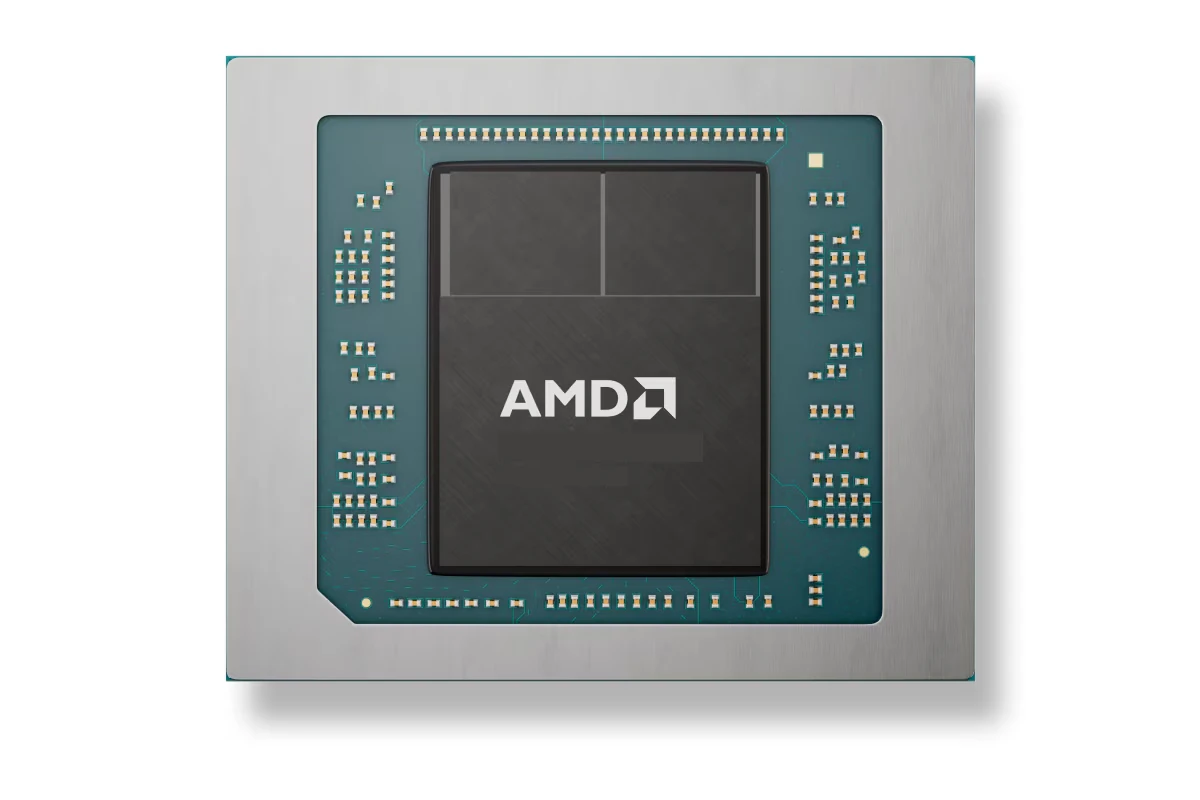AMD’s Strix Halo APUs are set to transform mobile computing by combining powerful CPU cores with a high-performance integrated GPU, offering enhanced graphics, core efficiency, and better energy consumption. With the launch of the Ryzen AI Max “Strix Halo,” AMD aims to compete with existing mobile solutions, catering to the increasing demand for efficient computing.
This new lineup, expected in 2025, promises to deliver performance that rivals dedicated mobile GPUs, potentially resulting in slimmer, lighter, and more affordable laptops suitable for demanding tasks like gaming and video editing.
Strix Halo: A Potential Game Changer for Laptop Graphics
What is Strix Halo?
AMD’s Strix Halo is an upcoming Accelerated Processing Unit (APU). It combines a powerful CPU with a high-performance integrated GPU. This design aims to offer strong graphics performance in laptops without needing a separate, dedicated graphics card. This approach could change the landscape of mobile gaming and content creation.
Specifications and Expected Performance
Strix Halo is expected to use AMD’s Zen 5 CPU cores and RDNA 3.5 graphics architecture. Leaks and rumors suggest some impressive specs:
- Up to 16 CPU cores
- Up to 40 compute units for the integrated GPU
- Performance targets suggest it may rival an NVIDIA RTX 4070 Laptop GPU
If these rumors are true, Strix Halo could bring desktop-level gaming performance to thin and light laptops. This would be a big step forward for integrated graphics.
Comparing Strix Halo to the Competition
Currently, most laptops with strong graphics need a dedicated GPU from NVIDIA or AMD. These GPUs add to the laptop’s size, weight, and cost. Strix Halo aims to provide similar performance without these drawbacks. Here’s a quick comparison:
| Feature | Strix Halo (Projected) | Laptops with Dedicated GPUs |
|---|---|---|
| Graphics Solution | Integrated RDNA 3.5 | Dedicated NVIDIA/AMD GPUs |
| Size and Weight | Smaller, lighter laptops | Larger, heavier laptops |
| Power Consumption | Potentially lower | Higher |
| Cost | Potentially lower system cost | Higher system cost |
The table shows that Strix Halo could offer advantages in portability, power use, and price. However, dedicated GPUs will likely still offer higher peak performance for demanding tasks.
What Does This Mean for the Future?
Strix Halo could significantly impact the laptop market. It could make high-performance gaming and content creation more accessible. It could also encourage more innovation in thin and light laptop designs. If successful, this approach could become more common in future laptops.
Release Date and Availability
Strix Halo is expected to launch sometime in 2025. Exact release dates and specific laptop models are not yet confirmed. Keep an eye out for announcements from AMD and laptop manufacturers.
Alternative Integrated Graphics Solutions
While Strix Halo is generating excitement, other integrated graphics solutions exist. Intel’s latest integrated graphics are improving, though they generally don’t reach the same performance level as dedicated GPUs or what Strix Halo is projected to achieve. Apple’s M-series chips also have strong integrated graphics, but they are limited to Apple’s ecosystem. These alternatives may be suitable for less demanding tasks, but Strix Halo is aiming for a higher performance tier.
What About Desktop PCs?
While Strix Halo is focused on laptops, the technology could influence desktop PCs as well. Future APUs with strong integrated graphics could be attractive for budget-conscious gamers or those who need a small, power-efficient system. This could open up new possibilities for small form-factor PCs and other desktop applications.
Beyond Gaming: The Impact on Content Creation
The strong integrated graphics of Strix Halo won’t only benefit gamers. Content creators like video editors and graphic designers could also see advantages. These professionals often need powerful graphics to handle demanding software. Strix Halo could provide enough performance for many of these tasks without needing a separate graphics card. This could make professional-grade laptops more affordable and portable.
Short Summary:
- The new Strix Halo series leverages AMD’s Zen 5 architecture along with RDNA 3.5 graphics to deliver excellent performance in AI workloads.
- Compared to Intel’s and Apple’s offerings, AMD’s chips provide significantly improved performance while maintaining a lower thermal design power (TDP).
- The Ryzen AI Max lineup is designed for mobile workstations, combining exceptional CPU and GPU cores in a highly efficient configuration.
AMD’s Strix Halo Unveiled
AMD has recently unveiled its Ryzen AI Max “Strix Halo” processors at CES 2025, a series that promises to set a new standard in mobile computing capabilities. With configurations reaching up to 16 CPU cores and 40 GPU cores, the Strix Halo lineup is notably adept at handling AI tasks and demanding graphics workloads, marking a significant leap forward in the competition against smaller alternatives from Intel and Apple.
The introduction of Strix Halo signifies AMD’s shifting focus towards integrated solutions that maximize performance while minimizing power consumption. Ben Conrad, Director of Product Management for AMD, emphasized this direction, stating,
“Our competitors are having to produce multiple products to cover similar markets, while we can achieve a lot with our single 300 Series lineup.”
Innovative Architecture and Design
The new Strix Halo processors are based on AMD’s innovative “big Middle” architecture, which utilizes the traditional Zen 5 cores instead of mixing smaller cores to achieve efficiency. This design maximizes performance without the scheduling penalties typically associated with heterogeneous core designs. According to Conrad, this setup allows for better optimization and less operational overhead.
“With our big Middle approach, higher performance is achieved without compromising scheduling efficiency,” he remarked. The architecture also integrates new features, such as AVX-512 capabilities and a memory interface that provides double the bandwidth of existing offerings.
The Power of Strix Halo
The Ryzen AI Max lineup includes several models, prominently featuring the Ryzen AI Max+ 395. This high-end variant touts impressive specifications, featuring:
- Core Configuration: Up to 16 Zen 5 CPU cores and 32 threads
- Boost Clock Speed: A maximum of 5.1 GHz
- Cache Size: An expansive 80 MB
- Graphics Power: 40 RDNA 3.5 compute units, providing substantial graphics performance
- TDP: Configurable between 45W and 120W
The Strix Halo’s sophisticated design leads to remarkable performance metrics. New benchmark results show the Ryzen AI Max+ 395 outperforming Intel’s Lunar Lake “Core Ultra 9 288V”, achieving up to 3 times better performance despite a lower TDP.
Competing Intelligently
In terms of direct competition, AMD launched the Strix Halo to challenge not only Intel’s Lunar Lake but also Apple’s M4 series. While the M4 Pro offers substantial power efficiency, AMD’s new chips deliver comparable or enhanced performance across various workloads while significantly improving the efficiency of thermal management.
“As we move forward, the combination of our Zen 5 architecture with RDNA 3.5 has set us apart from the competition,” asserted Conrad during our conversation. The optimized memory bandwidth of 256 GB/s brings the Ryzen AI Max lineup on par with offerings from high-end graphics cards like the RTX 4070, reinforcing AMD’s competitive edge.
Game and AI Workloads
AMD’s Strix Halo has been particularly positioned to thrive in AI and gaming environments. The Ryzen AI Max+ 395 is the first APU capable of running 70B large language models (LLMs) within this segment, boasting a >2.2x speed advantage over Nvidia’s RTX 4090 in AI processing tasks.
This advancement is pivotal for developers and consumers alike, as it demonstrates an APU capable of handling intensive computational tasks commonly associated with dedicated GPUs. Moreover, AMD’s newly developed NPU technology incorporates a class-leading 50 TOPS, further solidifying the Strix Halo’s capabilities in AI-driven applications.
Technical Specifications Overview
- Ryzen AI Max+ 395:
- Architectures: Zen 5 / RDNA 3.5
- Cores: 16 / Threads: 32
- Max Clock: 5.1 GHz
- Cache: 80 MB
- GPU Cores: 40 RDNA 3.5
- TDP: 45-120W
- Ryzen AI Max 390:
- Cores: 12 / Threads: 24
- Max Clock: 5.0 GHz
- Cache: 76 MB
- GPU Cores: 40 RDNA 3.5
- Ryzen AI Max 385:
- Cores: 8 / Threads: 16
- Max Clock: 5.0 GHz
- Cache: 40 MB
- GPU Cores: 32 RDNA 3.5
- Ryzen AI Max 380:
- Cores: 6 / Threads: 12
- Max Clock: 4.9 GHz
- Cache: 22 MB
- GPU Cores: 16 RDNA 3.5
This comprehensive suite of specifications sets the bar for what mobile workstations can achieve, and it positions AMD firmly for critical workloads previously dominated by Intel and Apple.
Market Impact and Future Prospects
The decisions made in the design and marketing of Strix Halo reflect AMD’s ambition to reshape the mobile computing landscape. With its unique features targeted towards AI and gaming content creators, the Strix Halo is well-equipped to meet the demands of modern computing.
“We understand the future trend of heightened performance combined with energy efficiency,” Conrad remarked. “With our APUs, users can experience high-level computing in a form factor they desire.”
The Ryzen AI Max series is anticipated to launch in various OEM devices, including laptops and mini PCs from well-known brands like HP and ASUS. This suggests a diverse range of products that will attract both gamers and professionals. Additionally, AMD’s Strix Halo APU series is set to redefine industry standards in mobile computing platforms. Their collaborative design philosophy has established a foundation for powerful, energy-efficient performance that challenges traditional market designs while providing significant value to end-users.







